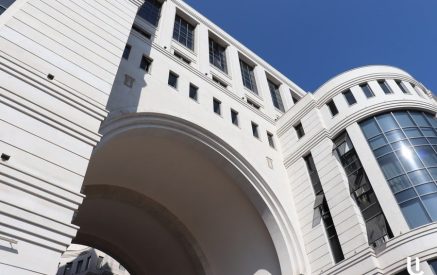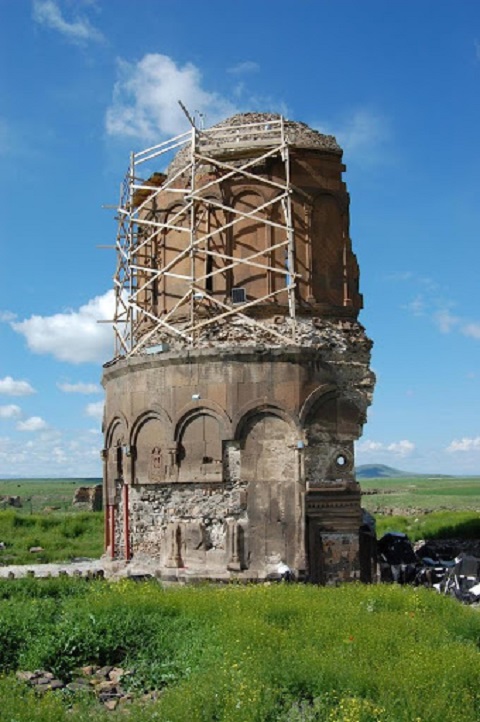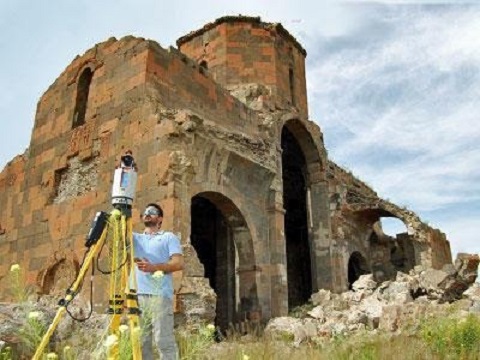The Armenian Weekly. I have always felt this magnetic affinity for classic architecture. It is based less on technical knowledge and more on a connection between what my eyes see and what my heart confirms. Several years ago, during a business trip to Milano, Italy, I was able to visit a few of the treasures in that city. Standing in the plaza outside the famed Duomo, I was stunned by the 135 spires that adorn this remarkable structure as I listened to my Italian associate tell me how generations of craftsmen worked their entire life on this work of art—one job their entire life. Later, upon the urging of my wife, I made my way to the church that houses Leonardo da Vinci’s iconic “The Last Supper.” It was my good fortune as it was the last day of public viewing before several years of restoration were to begin. I stood there in near silence for an hour as I absorbed the beauty, the talent, the details and its ageless relevance. The first time I went to Armenia, one of my priorities was to visit the Soorp Hripsime Church. When I think of the eternal beauty of Armenian church architecture, I think of Soorp Hripsime. When I was a teenager, the church in Indian Orchard was destroyed by a fire. The community built a new church and the architect was the late Arshag Mergerian whose design was inspired by both Soorp Hripsime and the Soorp Khatch Cathedral on Akhtamar (cruciform with centered dome). I remember studying historical pictures as the construction took shape.
When I arrived in Armenia, I was fortunate to attend Soorp Badarak at the church. While witnessing the “topor” (procession near the beginning of the service), I was overwhelmed with emotion as I thought of the thousands of ancestors who walked the huge stone slabs of the floor that I was now standing upon. Gazing at the angular niches, artistic apses and centered dome, my love of the design and 1,500 years of history of this church left me in tears. I left completely drained but with a feeling that we must preserve what we have and continue to build for the future. This is one of the foundations of our civilization, and we are the current gatekeepers. This column has been primarily dedicated to raising the awareness and visibility to our community of issues of importance to our greater nation. Essentially, we have two responsibilities as concerned Armenians: to become informed participants in our communities and to continue the work that enables the sustaining of our identity. I look at it like a relay race. We each have our moment of receiving the baton from a predecessor, carrying our “leg” in the race and then passing it to a successor. In order to contribute, though, we must be in shape to compete and have the self-discipline to develop our talents. Our “teammates” are depending on it. The self-discipline is what creates informed Armenians who can then help others. Scattered throughout the western highlands are “survivor” monuments that are an opportunity to exercise our “leg” in the race.
What can we do, what should we do and what must we do to prevent the further destruction of our monuments? Ironically, the biggest threat is ignorance. As Armenians who are generationally and geographically removed from these structures in the occupied lands of Western Armenia, it often doesn’t make the “cut” in our priorities. This lack of knowledge and awareness is a challenge worth investing in. What can any of us do if we lack a basic moderating of the geography of the western highlands and the treasures contained therein? We should all make a personal commitment to read about the churches and other monuments that have survived. Google is obviously one simple tool to find basic information on Mren, Ani, Surp Giragos and others scattered in the provinces. What is their history and their current condition? Are there any current efforts with the World Monuments Fund (WMF) or UNESCO and the Turkish government to stabilize and restore these treasures?
We are more than genocide victims.
I have recommended Matthew Karanian’s The Armenian Highland: Western Armenia and the First Armenian Republic of 1918 as an excellent teaching resource for the family and as a reference publication. Further details are available from several books on Armenian architecture, including Dr. Christina Maranci’s Vigilant Powers: Three Churches of Early Medieval Armenia. There are also an increasing number of public lectures and symposiums on this subject matter. With the use of technology, interactive forums are being offered on video platforms and streaming options. This allows virtually anyone in the diaspora and Armenia to have access to this information. Useful resources for this can be found through the websites of National Association for Armenian Studies and Research (NAASR), Ararat-Eskijian Museum and the Society of Armenian Studies (SAS). There is no substitute for knowledge. It is essential for any value-added activity. We have never been in a better position with regards to the availability of general information.
The WMF is an important organization in the preservation of our monuments. Once the application to have a monument placed on the Watch List is accepted, it remains on the list for three years. This event triggers an internal process at WMF between their sponsor funding agencies and, in our case, the Turkish Ministry of Culture and Tourism. If successful, then various resources, including Armenian experts and NGOs in Turkey, are assembled. The initial work, as in the cases of Mren and Ani, begins with site visits and data collection to assemble a plan for stabilization and hopefully restoration. It is a tricky and somewhat unpredictable process given the political, economic and public perception issues. I recently asked Dr. Maranci how the process starts and if there is an Armenian organizational effort. I was shocked to learn that our applications have been initiated by individuals such as Dr. Maranci, and to her knowledge (and she has been a player for years) there is no organizational focus to sustain activity, lobby the decisions or even to raise funds for projects. Dr. Maranci did say that once an approval is given, there is a group of individuals (specialists in art, engineering and design) that usually assembles, but that it is based on their individual dedication. This sounds like an opportunity where the Armenian community across the globe can lend its support to help sustain the efforts. A more structured interdisciplinary group of artists, architects, engineers, activists and historians could probably improve the front end of the process and identify opportunities to influence the outcome. Our quiet heroes who have been holding this together deserve more communal support. In 2011-2012, Congress passed the “Return of Churches” resolutions to encourage Turkey to return confiscated churches and respect religious freedom. Is this still on the radar of Congress, the Armenian National Committee of America (ANCA) and Armenian Assembly? These must be long-term sustainable efforts, regardless of the short-term thinking of our Washington Beltway politics.
Another area for long-term development is to encourage a scholarly foundation in this regard. Dr. Maranci is a professor of art and architecture. She has become a recognized expert in her field. Where are the additional or next Marancis coming from? I was encouraged to learn that this semester she has over 100 students who will be learning about Armenian art and architecture. From these students, there may be some who matriculate into graduate programs and internships in Armenia. What are we doing at the high school level to bring the beauty of Armenian art and architecture into their lives? Each of us can encourage, mentor or create programs that create this visibility. Tomorrow’s scholars are in middle schools and high schools now. We need to focus on more than just history which is certainly important, but other disciplines also must be encouraged. It starts with emphasizing education at several levels.
NAASR has sponsored many programs geared toward an older audience. Currently, there are discussions to design programs for secondary school audiences on Armenian art and architecture. In my view, our communities have become too “genocide-centric” and this has led to a narrow approach in education. The beauty of our culture, specifically our art and language, are of equal importance. Ask yourself how much our children are exposed to our art culture in our current programming. An introduction to art is generally through a visual medium and will be attractive to younger audiences. Displaying Armenian art on the walls of your home and having books visibly available will build a natural appreciation for art at an early age. We need more visual educational material utilizing the power of the digital age with animation and graphics that make learning about Armenian art accessible, fun and impactful. These are all areas where we can invest our time to create a more substantive environment for our future.
The intent of this week’s column is to articulate the almost endless possibilities of contributing to the preservation and vibrancy of our art and architecture. The monuments in the western highlands await our participation. Their cries for assistance must be answered now. The definition of participation is very broad. In order to preserve, we lend our assistance. In order to be effective, we must be informed and educated. There are many accessible opportunities to accomplish that necessity. You can also be a contributor to expanding the value we place on Armenian art and architecture in our communities, in your home and in our formal education. All of these will contribute to the challenge. We are more than genocide victims. It is anticipated that new Watch List applications will be made to WMF in early 2021. Please consider advocating for their acceptance. The WMF can be reached at the Empire State Building, 350 Fifth Ave., Suite 2412, New York, New York 10118 (tel. 646-424-9594) or on their Facebook page. Our inheritance is a sacred responsibility.
Stepan Piligian
Main caption: Exterior scaffolding of the Holy Redeemer (Amenap’rkitch) Church in 2013 (Photo: World Monuments Fund)

























































